I HAVE written on this subject, but this time I will be more specific.
FROM
Botany for Gardeners
Brian Capon
page 103
FROM
Botany for Gardeners
Brian Capon
page 103
Most species are unable to elevate leaves high above the ground on thin, herbaceous stems. But not so with climbing vines that make deft use of their specially adapted organs, and the strength of suitable supports, to accomplish such a feat.
The stems of some vines grow in a spiral manner around upright objects such as a small trunks of shrubs or saplings, or fence posts and telephone poles. Stems displaying, such characteristic growth are called twiners. The higher a twining stem
grows, the more tightly it hugs its support.
Other species form special grasping organs, called tendrils, that are either modified leaf parts or short stems derived from the growth of axillary buds. Tendrils
coil around small objects with which they come into contact-the stems of other plants,
or garden stakes, fence wires and strings supports. Once anchored, the principal stem
grows upward a short distance before sending out more tendrils. Leaf tendrils are
adapted from leaflets of compound leaves (Sweet Pea, for example), stipules (Green
Briar), or petioles (Clematis).
In other species, climbing structures include short branches with adhesive disks at their tips. With such devices , Virginia Creeper (Parthenocissus spp.) clings tenaciously to the walls of buildings. Or the climbing stems of ivy, for example, form
adventitious roots that penetrate and expand in cracks in tree bark, wooden fences,
masonry, etc. With age, some climbing stems become woody and bear heavy leaf
loads; but by then, they are so securely anchored it is extremely difficult to separate
them from their supports.
It is a good time to remind our far away readers that vines are under used in most installations. A good resource that could substitute wisely over used hedges. With vines one does not need to be on top of them as in a hedge.
With that in mind lets mention some issues that are pertinent based on
my experience/collection.
Do not plant Bejuco de puerco. This one will violate the boundaries day after day. Vines like this behave as ground covers if they reach the ground from above. It will grow roots even over concrete/asphalt.
In terms of aesthetics Cavalinna maritima, Passiflora edulis and Petrea volubilis, have a STIFF appearance. Very stiff. That is why I have an intense dislike for palms, hedges and turf among others.
Disease/insects are not a problem with these. They will require some pruning once in a while, particularly when they embrace other vegetation, trees.
Ipomoeas are nice looking, but prone to white flies, a pain in the rear.
However, Merremia quinquefolia, Clitoria ternatea, Antigonon leptopus,
are less wild than those above. All these have a soft look, falling gently,
like a cascade. Birds are fond of them while hiding/playing.
As they grow on the windows iron works, they become a screen reducing
the glare significantly. These vines have a bonus when the light goes trough them. The leaves form beautiful arabesques with the aid of the wind, on windows and walls. So there, go and get some. Time to go...
The stems of some vines grow in a spiral manner around upright objects such as a small trunks of shrubs or saplings, or fence posts and telephone poles. Stems displaying, such characteristic growth are called twiners. The higher a twining stem
grows, the more tightly it hugs its support.
Other species form special grasping organs, called tendrils, that are either modified leaf parts or short stems derived from the growth of axillary buds. Tendrils
coil around small objects with which they come into contact-the stems of other plants,
or garden stakes, fence wires and strings supports. Once anchored, the principal stem
grows upward a short distance before sending out more tendrils. Leaf tendrils are
adapted from leaflets of compound leaves (Sweet Pea, for example), stipules (Green
Briar), or petioles (Clematis).
In other species, climbing structures include short branches with adhesive disks at their tips. With such devices , Virginia Creeper (Parthenocissus spp.) clings tenaciously to the walls of buildings. Or the climbing stems of ivy, for example, form
adventitious roots that penetrate and expand in cracks in tree bark, wooden fences,
masonry, etc. With age, some climbing stems become woody and bear heavy leaf
loads; but by then, they are so securely anchored it is extremely difficult to separate
them from their supports.
It is a good time to remind our far away readers that vines are under used in most installations. A good resource that could substitute wisely over used hedges. With vines one does not need to be on top of them as in a hedge.
With that in mind lets mention some issues that are pertinent based on
my experience/collection.
Do not plant Bejuco de puerco. This one will violate the boundaries day after day. Vines like this behave as ground covers if they reach the ground from above. It will grow roots even over concrete/asphalt.
In terms of aesthetics Cavalinna maritima, Passiflora edulis and Petrea volubilis, have a STIFF appearance. Very stiff. That is why I have an intense dislike for palms, hedges and turf among others.
Disease/insects are not a problem with these. They will require some pruning once in a while, particularly when they embrace other vegetation, trees.
Ipomoeas are nice looking, but prone to white flies, a pain in the rear.
However, Merremia quinquefolia, Clitoria ternatea, Antigonon leptopus,
are less wild than those above. All these have a soft look, falling gently,
like a cascade. Birds are fond of them while hiding/playing.
As they grow on the windows iron works, they become a screen reducing
the glare significantly. These vines have a bonus when the light goes trough them. The leaves form beautiful arabesques with the aid of the wind, on windows and walls. So there, go and get some. Time to go...


















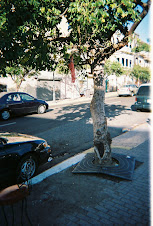-25.jpg)
-24.jpg)
























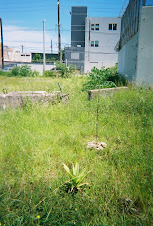




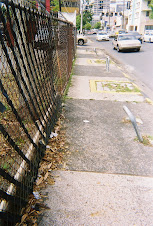
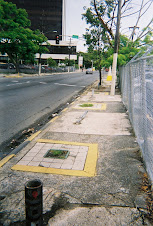
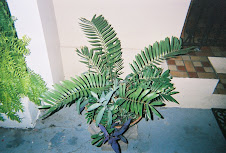




-22.jpg)
-25.jpg)
-24.jpg)






-16.jpg)
-13.jpg)
-08.jpg)
































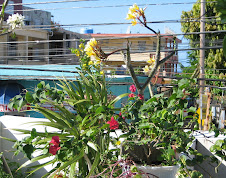
















No hay comentarios:
Publicar un comentario